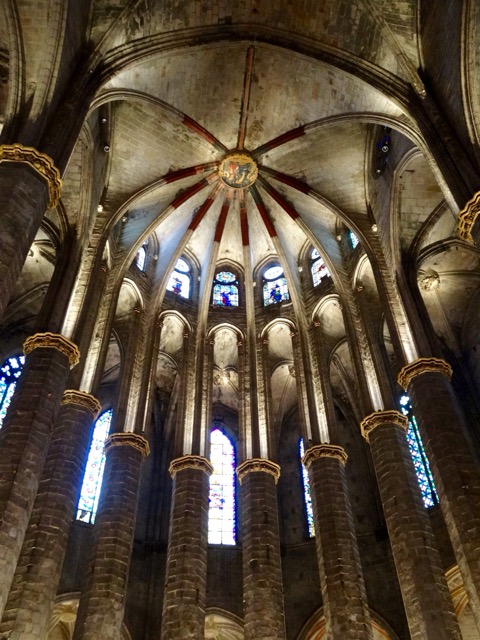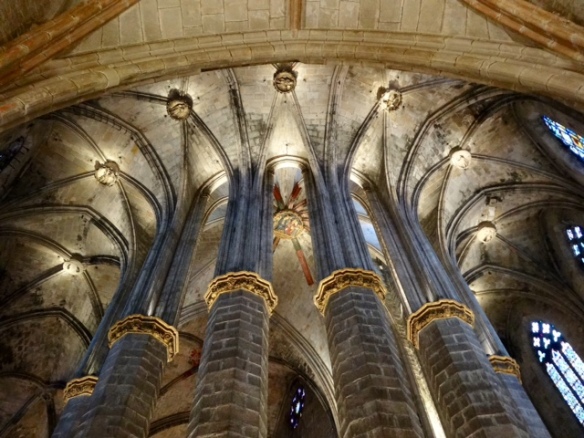I know I am terribly slow finishing these last few posts from our trip but finally, I am going to get it done. Thanks for hanging in and being patient.
Sunday, December 6, 21015
We only have four days left until we leave for home and there is still so much we haven’t seen. It is difficult to believe we have been travelling for almost three months and now it is almost over. Today we are going to visit the Picasso Museum and the Frederic Maré Museum. They are both free today as it is the first Sunday of the month.
On the way to the Picasso Museum we pass the MEAM (European Museum of Modern Art) where we saw the Odd Nerdrum Exhibit way back in September. All the streets in this area are very narrow and I am glad Bob seems to know where we are going, because I certainly don’t!
The Picasso Museum is always busy and today we need to line up and wait to get in but the line moved fairly quickly and we were entertained by this very talented group of musicians while we waited.
There are no photos allowed inside the museum and they are very strict, so I have no pictures of what we saw, but here is a link to the museum collection if you want to see some of the work on display. 
 The Picasso museum is located in five large town houses or palaces. The original palaces date from the 13th-15th centuries, and the buildings have undergone major restorations. The museum is quite ornate and has many interesting architectural details and courtyards. We spent several hours here, there is so much to see; there are 4,251 works in the permanent collection!
The Picasso museum is located in five large town houses or palaces. The original palaces date from the 13th-15th centuries, and the buildings have undergone major restorations. The museum is quite ornate and has many interesting architectural details and courtyards. We spent several hours here, there is so much to see; there are 4,251 works in the permanent collection!
On our way to the next museum we stop to visit the Santa Maria Del Mar.
This church was damaged by fire in 1936 and we can still see soot on the walls and ceilings, and the damage that the fire did to its columns. 

The columns are spaced 43 feet apart, the widest of any Gothic Church in Europe. This church was built in just 55 years, from 1329 to 1384 and it is the only surviving church in the Catalan Gothic style. The interior is quite beautiful, and full of light even though it is not ornately decorated like so many of the churches that we have seen.

We climb some old stone steps and there is a great view from the second floor behind the altar looking towards the front doors and beautiful stained glass windows.


Next stop, the Frederic Maré Museum. We had a very brief visit to this museum in September but it was closing so we had to dash through the little bit of it that we saw. It was a fascinating place and we wanted to return for a more leisurely visit. There is a lovely secluded courtyard right outside this museum so we stop for a much needed rest and a rather late lunch.
This quote from the museum’s site explains this rather curious museum, and a virtual reality tour gives a better idea of our visit to this fascinating museum.
“The Museu Frederic Marès is a unique collecting museum that preserves the collections assembled by its founder, sculptor Frederic Marès (1893-1991), which came to form part of the patrimony of the city of Barcelona through his donation in 1946. Two years later, this museum was inaugurated in a part of the old Royal Palace of the Counts of Barcelona in the heart of the Gothic Quarter. Its original Verger or courtyard garden, still remains intact.
Frederic Marès turned sculpture into something beyond his artistic calling. Throughout his lifetime he amassed an extensive Hispanic sculpture collection which ranged from the ancient world until the 19th century, in which religious polychromed carvings predominated. This now makes up the most uniform section of the museum. Marès also donated part of his own sculptural oeuvre, which is on display in his Library-study.
The Collector’s Cabinet is the home to a display of tens of thousands of objects that make up a vast collection of collections that documents past lifestyles and customs, mainly from the 19th century. There you can find amusing, unique items like fans, pipes, clocks, jewellery, photographs, toys, keys, pharmacy bottles and reliquaries, all presented in an intimate atmosphere evoking Marès private universe.”
Here are some of my pictures of this incredible collection.
There was an old picture of the Liceu Opera House, where we will see an opera tomorrow.
We make our way back to the Barcelona Cathedral to get a picture. Last time we were there, a large tent and stage ere erected in front of it which made picture taking difficult. Today there is a Market in the square in front of the Cathedral, so there are balloons in my photo and lots of people everywhere. 
 There were Christmas tree vendors, and several families were buying their trees,
There were Christmas tree vendors, and several families were buying their trees,
and there were rows and rows of stalls selling nativity scene figurines and crèches of all styles, sizes and shapes.
We leave this busy street and catch the metro back to our neighbourhood and our narrow, quiet street.










 We end up right back where we started after walking in a big circle so we head for a Metro station near Plaza Mayor, and encounter hordes of people.
We end up right back where we started after walking in a big circle so we head for a Metro station near Plaza Mayor, and encounter hordes of people.





















